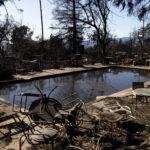Federal officials have designated portions of 11 drought-ridden western and central states as primary natural disaster areas, highlighting the financial strain the lack of rain is likely to bring to farmers in those regions.
The announcement by the U.S. Department of Agriculture last week included counties in Colorado, New Mexico, Nevada, Kansas, Texas, Utah, Arkansas, Hawaii, Idaho, Oklahoma and California.
The designation means eligible farmers can qualify for low-interest emergency loans from the department.
Agriculture Secretary Tom Vilsack said he and President Obama want to ensure that agriculture remains a bright spot in the nation’s economy.
“USDA stands with you and your communities when severe weather and natural disasters threaten to disrupt your livelihood.” he said in statement.
Counties adjacent to those affected also are eligible for assistance.
While storms have dumped rain and snow in the East, droughts are persisting or intensifying in the West, according to officials connected with the U.S. Drought Monitor, an index on which the USDA’s declarations are based. A ridge of high pressure is to blame for keeping storms off the Pacific coast and guiding them to the East.
“What we’re seeing meteorologically is a blocking pattern that is deflecting all the storms,” said Brian Fuchs, a climatologist with the Lincoln, Neb.-based National Drought Mitigation Center. “There really hasn’t been a lot of indication that this pattern is breaking down.”
Poor snowpack is threatening regions dependent on major western rivers, and no amount of wet winter weather in the East can ease the pain, officials said.
“Once you cross the Rockies, nothing on the East is going to help you,” Fuchs said.
The dry weather could mean an active fire season. Southern California had an early taste of that with a blaze that started last Thursday morning in the foothills of the San Gabriel Mountains and forced nearly 2,000 people to evacuate. At least two homes were burned.
Three men were arrested on suspicious of recklessly starting a fire. They’re accused of tossing paper into a campfire in the dangerously windy and dry conditions.
“We don’t say the drought causes the fires,” Fuchs said. “But when you have fire season and drought, you’ll see more fire.”





















 Will California’s FAIR Plan Have Enough Cash for Its Wildfire Claims?
Will California’s FAIR Plan Have Enough Cash for Its Wildfire Claims?  Smoke, Coverage Issues Cloud Wildfire Forecast: $35-$45B Losses Insured
Smoke, Coverage Issues Cloud Wildfire Forecast: $35-$45B Losses Insured  Update: LA Wildfire Insurance-Loss Estimates Approach $40 Billion
Update: LA Wildfire Insurance-Loss Estimates Approach $40 Billion  First 2025 Atlantic Hurricane Season Forecasts 7 Named Storms
First 2025 Atlantic Hurricane Season Forecasts 7 Named Storms 

